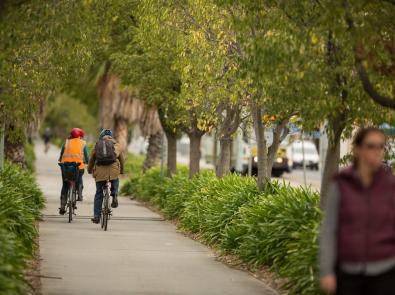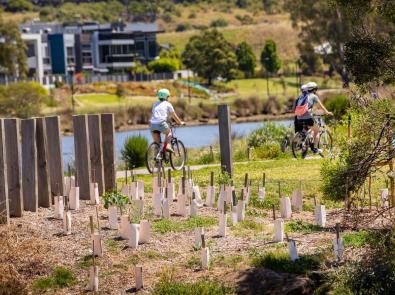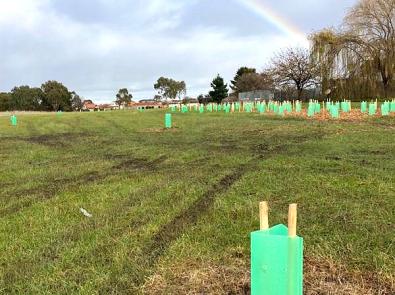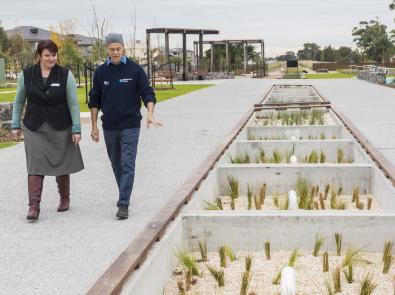Hotter and more frequent heatwaves are having the largest impact on our cities, due to the urban heat island effect. Find out how we’re offsetting this by shading, cooling and greening Melbourne’s public spaces – so you can enjoy them more days of the year.
Watch the following video for an overview of our Urban Cooling Program, or read on to learn about some of our projects:
Why give Melbourne shade?
We know cities are built with concrete, stone and asphalt-paved roads. But did you know these hard materials create ‘heat islands’ – areas of significantly hotter temperature than surrounding suburban and rural areas?
Built-up areas have a greater capacity to absorb, hold and emit the sun’s heat compared to rural areas. The absorption of energy can increase day and night time temperatures in cities by several degrees.
City Cooling – Mitigation of the Urban Heat Island Effect, E2Designlab 2019
Planting trees and providing water not only helps cool our city, but can also improve amenity, create habitat and lessen the impact of stormwater pollution on our rivers and creeks.
Cooler for us
Growing evidence shows we can effectively lower local temperatures by planting trees to create more shade. In fact, standing under a tree in the shade can feel 10 degrees cooler than standing in the sun.
Creating tree cover over walking and cycling trails allows them to be used more days of the year – improving recreational opportunities and community health and wellbeing.
Cooler for the environment
Trees and shrubs need a consistent water supply to withstand hotter temperatures, heatwaves and drought. But watering can also make heatwaves feel cooler: irrigated grass is about 15 degrees cooler than dry grass and pavements, and can bring nighttime temperatures down by one degree per hour.
Cooler for animals
The native animals living in our cities are also affected by limited water and trees. Using plants and water to cool spaces can also provide them with vital habitat.
Our projects
As the manager of over 33,000 hectares of land in Greater Melbourne, we’re doing our part to make Melbourne cooler and greener. Through our Urban Cooling Program and projects like ‘Greening the Pipeline’, we’re working with councils and community groups to transform exposed parklands, paths and trails into enjoyable community spaces.
In 2020, we planted trees along wetland paths and waterways to create 30 hectares of shade: equal to about 15 MCGs! This is expected to reduce local temperatures by up to four degrees on hot days.
Our projects have targeted sites in Melbourne’s north, southeast and inner west that are:
- close to homes
- used for recreation, transport and community education
- hot and dry in summer.
View some of our projects below.
- Jacana Wetlands, Gladstone Park
-
Plantings at the Jacana Wetlands, delivered through our urban cooling program. With support from Hume City Council, we’ve collaborated with the Friends of Moonee Ponds Creek to enhance natural biodiversity of parklands and a major bicycle commuter route along a key waterway.
In mid-2018 we planted:
- 170 native Red Gum trees to create shade for walkers and joggers
- 12,500 native shrubs to create understory garden beds between the path and wetland, reducing dog access to important frog habitat.
- Edithvale Wetlands, Edithvale
-
The Edithvale Wetlands, one of the sites targeted for cooling. We’ve worked with the Friends of Edithvale-Seaford Wetland to select plant species and planting locations to create shade for walkers and joggers, enhance biodiversity and retain lines of sight across the area.
As part of this project, supported by Kingston City Council, we planted:
- 200 native trees (Australian Oaks, Peppermints and Manna Gums) along paths connecting a local bus stop with our Wetland Education Centre
- 4,000 native shrubs to provide habitat for birds.
- Maribyrnong River
-
Plantings at Burndap Park, along the Maribyrnong River. In partnership with Maribyrnong City Council we planted 250 native trees (mix of eucalyptus species) at:
- Burndap Park
- Burton Crescent Reserve
- Maribyrnong River Reserve (near the Heavenly Queen Temple).
That’s six hectares more shade trees for greening and cooling the Lower Maribyrnong that are now growing well.
- Galada Tamboore, Campbellfield
-
Plantings at Galada Tamboore. We worked with Merri Creek Management Committee and Hume City Council to design a project that will enhance amenity and public use of the shared path through Galada Tamboore, while protecting remnant grassland vegetation and biodiversity values within the reserve. The project will create tree canopy over a 1.2 km stretch of the Merri Creek Trail.
We planted:
• 120 red gum and sheaok trees
• 1700 native shrubs and grasses.
Other greening initiatives
Given competing demands for water, we’re investigating how much is needed and available long term for greening and cooling. This ensures we plan and secure alternative water sources to create a greener, cooler Melbourne – especially during periods of low rainfall.
Different approaches to planning and urban design, like water sensitive urban design and integrated water management, are vital to making our parks and gardens resilient to rising temperatures, heatwaves and drought.
Simple stormwater systems can remove pollution and chemicals from stormwater so it can be used to water trees (sometimes doubling their growth rate), while reducing impacts on rivers and creeks.
We see a strong opportunity to make urban trees more resilient to Victoria’s changing climate, by aligning the need to manage excess stormwater runoff and protect waterways, with the need to keep trees and green spaces healthy and thriving.
You may also like...
Greening the Pipeline
Greening the Pipeline is an ambitious project to transform the Main Outfall Sewer reserve along the Federation Trail into a greener, cooler parkland for our communities in Melbourne’s west.









